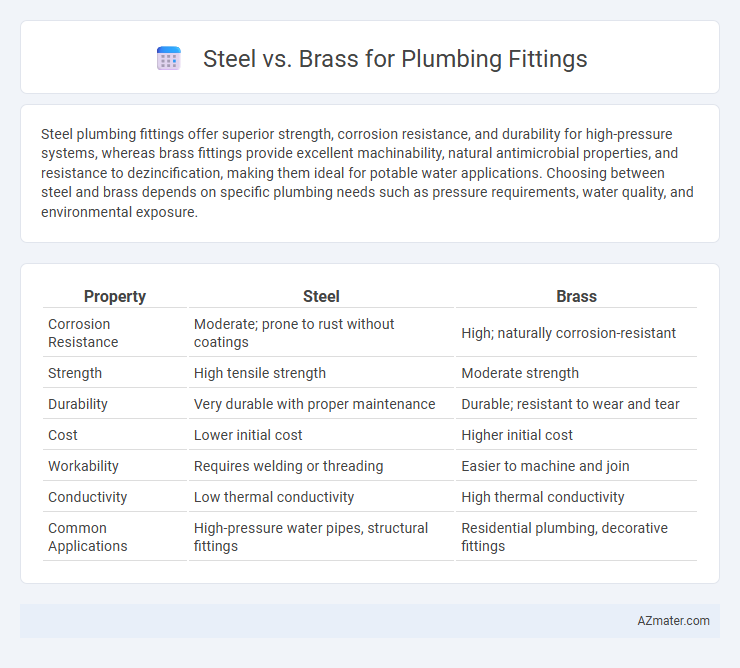Steel plumbing fittings offer superior strength, corrosion resistance, and durability for high-pressure systems, whereas brass fittings provide excellent machinability, natural antimicrobial properties, and resistance to dezincification, making them ideal for potable water applications. Choosing between steel and brass depends on specific plumbing needs such as pressure requirements, water quality, and environmental exposure.
Table of Comparison
| Property | Steel | Brass |
|---|---|---|
| Corrosion Resistance | Moderate; prone to rust without coatings | High; naturally corrosion-resistant |
| Strength | High tensile strength | Moderate strength |
| Durability | Very durable with proper maintenance | Durable; resistant to wear and tear |
| Cost | Lower initial cost | Higher initial cost |
| Workability | Requires welding or threading | Easier to machine and join |
| Conductivity | Low thermal conductivity | High thermal conductivity |
| Common Applications | High-pressure water pipes, structural fittings | Residential plumbing, decorative fittings |
Introduction to Steel and Brass Plumbing Fittings
Steel plumbing fittings offer exceptional strength, corrosion resistance, and durability, making them ideal for high-pressure applications and industrial plumbing systems. Brass fittings provide excellent machinability, natural antimicrobial properties, and superior resistance to corrosion from water, making them popular in residential water supply and HVAC systems. Both materials play crucial roles in plumbing, with steel favored for heavy-duty use and brass preferred for its versatility and reliable performance in potable water systems.
Key Properties of Steel in Plumbing Applications
Steel plumbing fittings offer exceptional strength and durability, making them ideal for high-pressure water systems and structural support in piping networks. Their resistance to corrosion, especially when galvanized or stainless, ensures longevity and reduces maintenance in plumbing applications exposed to moisture. Steel's heat tolerance also allows safe use in hot water systems, maintaining integrity under temperature fluctuations common in residential and commercial plumbing.
Major Characteristics of Brass Plumbing Fittings
Brass plumbing fittings are highly valued for their excellent corrosion resistance, making them ideal for water supply lines and fittings exposed to moisture. Their malleability allows easy shaping and installation, while maintaining durability and strength under high pressure. Brass also resists dezincification, ensuring long-lasting performance and maintaining water purity in domestic and industrial plumbing systems.
Corrosion Resistance: Steel vs. Brass
Brass exhibits superior corrosion resistance compared to steel, making it an ideal choice for plumbing fittings exposed to moisture and varying pH levels. Steel, particularly carbon steel, is prone to rust when exposed to water and oxygen, necessitating protective coatings or treatments to prevent corrosion. Stainless steel offers enhanced resistance but generally comes at a higher cost than brass, which naturally resists rust and mineral buildup in plumbing applications.
Strength and Durability Comparison
Steel plumbing fittings exhibit superior strength and durability compared to brass, offering high resistance to mechanical stress and pressure, which makes them ideal for heavy-duty applications. Brass fittings provide excellent corrosion resistance and longevity but have lower tensile strength than steel, making them better suited for residential water systems where flexibility and corrosion resistance are prioritized. Steel's robustness against impact and wear ensures longer service life in demanding environments, while brass's resistance to dezincification enhances durability in water exposure.
Cost Differences Between Steel and Brass Fittings
Steel fittings generally cost less than brass fittings due to the lower raw material price and simpler manufacturing process associated with steel. Brass fittings offer superior corrosion resistance and durability, which justifies their higher price point in plumbing applications requiring longevity and reliability. Choosing between steel and brass fittings often depends on budget constraints and specific performance needs in plumbing systems.
Installation and Maintenance Considerations
Steel plumbing fittings offer high strength and durability but require careful handling during installation to prevent corrosion and ensure secure threading, often necessitating the use of specialized tools and anti-corrosion coatings. Brass fittings provide excellent corrosion resistance and easier machinability, making installation quicker and reducing the risk of leaks without extensive maintenance. Maintenance for steel fittings involves regular inspection for rust and timely application of protective coatings, whereas brass fittings generally need less frequent upkeep due to their inherent resistance to scale and corrosion.
Common Use Cases for Steel Plumbing Fittings
Steel plumbing fittings are commonly used in high-pressure applications such as industrial piping systems, fire sprinkler systems, and gas lines due to their strength and durability. They offer excellent resistance to corrosion and high temperatures, making them ideal for water supply lines and steam systems in commercial buildings. Compared to brass fittings, steel fittings are preferred in environments requiring robust mechanical performance and longevity under strenuous conditions.
Typical Applications for Brass Plumbing Fittings
Brass plumbing fittings are widely used in potable water systems due to their excellent corrosion resistance and antimicrobial properties, making them ideal for residential and commercial water supply lines. These fittings are commonly found in valves, faucets, and connectors where durability and leak prevention are critical. Brass is preferred over steel in applications requiring resistance to dezincification and where high thermal conductivity supports efficient water heating systems.
Choosing the Right Fitting for Your Plumbing Needs
Steel plumbing fittings offer superior strength and corrosion resistance, making them ideal for high-pressure applications and outdoor use, while brass fittings provide excellent durability with natural antimicrobial properties, making them suitable for residential water systems. Selecting the right fitting depends on factors such as water type, system pressure, and environmental conditions; steel is preferred for industrial or heavy-duty use, whereas brass is favored for domestic plumbing due to its ease of installation and resistance to corrosion. Understanding material composition, lifespan expectations, and compatibility with existing pipes ensures optimal performance and longevity in plumbing installations.

Infographic: Steel vs Brass for Plumbing Fitting
 azmater.com
azmater.com